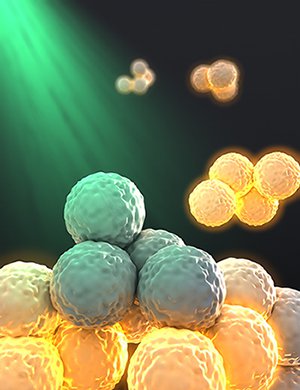PHOTOBLEACHING
 In our lab, we use various fluorescence based assays to rapidly detect very low concentration of biomarkers. In these assays, usually a target molecule is captured using a probe conjugated to a capture surface and then detected using a second fluorescently labeled probe. One of the most common capture surfaces is a magnetic bead. However, magnetic beads exhibit strong autofluorescence, which often overlaps with the emission of the reporter fluorescent dyes and limits the analytical performence of the assay. In this research, we photobleached several widely used magnetic beads and reduced their autofluorescence to 1% of the initial value. We analyzed their autofluorescence properties and the stability of the photobleaching over a period of two months.
The photobleached beads were stable over time and their surface functionality was retained. In a high sensitivity LX-200™ system using photobleached magnetic beads, human interleukin-8 was detected with a 3-fold improvement in detection limit and signal to noise ratio over results achievable with non-bleached beads.
In our lab, we use various fluorescence based assays to rapidly detect very low concentration of biomarkers. In these assays, usually a target molecule is captured using a probe conjugated to a capture surface and then detected using a second fluorescently labeled probe. One of the most common capture surfaces is a magnetic bead. However, magnetic beads exhibit strong autofluorescence, which often overlaps with the emission of the reporter fluorescent dyes and limits the analytical performence of the assay. In this research, we photobleached several widely used magnetic beads and reduced their autofluorescence to 1% of the initial value. We analyzed their autofluorescence properties and the stability of the photobleaching over a period of two months.
The photobleached beads were stable over time and their surface functionality was retained. In a high sensitivity LX-200™ system using photobleached magnetic beads, human interleukin-8 was detected with a 3-fold improvement in detection limit and signal to noise ratio over results achievable with non-bleached beads.
In January 18, 2019, our paper on photobleaching was published on the inside front cover of Small.
The paper, entitled 'Photobleaching: Improving the Sensitivity of Fluorescence‐Based Immunoassays by Photobleaching the Autofluorescence of Magnetic Beads', can be found in the Publications section, and at DOI: 10.1002/smll.201970016.
